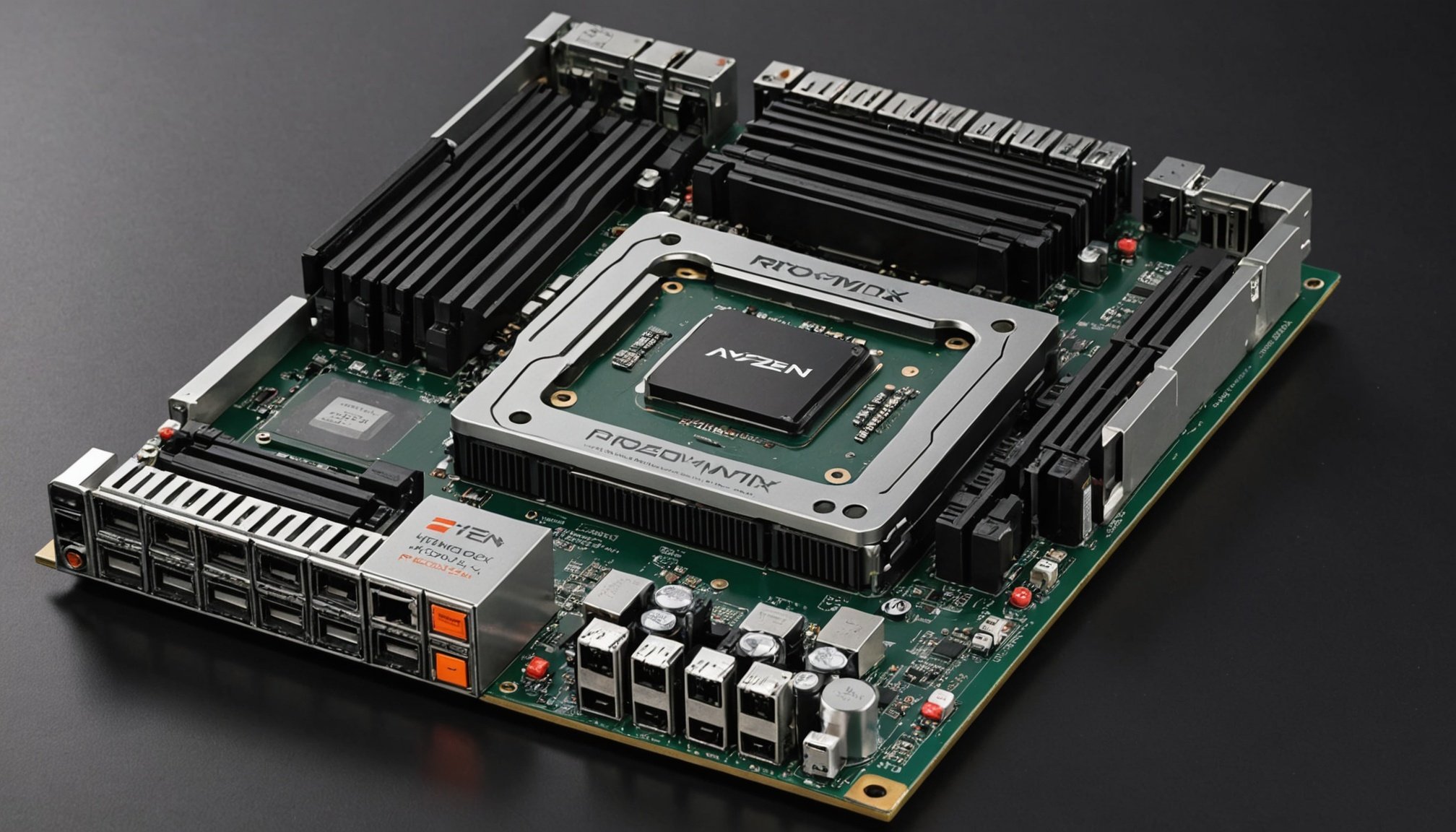Unlocking the Power of Proxmox VE: A Comprehensive Guide to Building a High-Performance Virtualization Server on Your AMD Ryzen 9 5900X
Why Choose Proxmox VE and the AMD Ryzen 9 5900X?
When it comes to building a high-performance virtualization server, the combination of Proxmox VE and the AMD Ryzen 9 5900X is a powerhouse that can handle even the most demanding tasks. Proxmox VE, short for Proxmox Virtual Environment, is an open-source server virtualization platform that offers a robust and feature-rich environment for running virtual machines (VMs) and Linux containers (LXC).
The AMD Ryzen 9 5900X, with its 16 cores and 32 threads, provides the processing muscle needed to run multiple VMs and containers efficiently. Here’s why this combination is ideal:
Also read : Unlock extended battery performance: pro strategies for tuning power settings on your hp zbook firefly 15 g7
- Processing Power: The Ryzen 9 5900X offers exceptional multi-threaded performance, which is crucial for virtualization tasks that often require handling multiple workloads simultaneously.
- Cost-Effectiveness: Compared to Intel Core or Xeon processors, the Ryzen 9 5900X can offer similar or better performance at a lower cost, making it a great value for your money.
- Compatibility: Proxmox VE supports AMD processors seamlessly, and the Ryzen 9 5900X is no exception, ensuring smooth and stable operation.
Choosing the Right Hardware Components
Building a high-performance virtualization server requires careful selection of each hardware component. Here’s a detailed guide to help you make the right choices:
CPU: AMD Ryzen 9 5900X
The Ryzen 9 5900X is the heart of your server, providing the necessary processing power. Here are some key features:
Also to read : Crucial strategies for safeguarding data security while transferring files on your western digital my passport ssd
- 16 Cores and 32 Threads: Ideal for running multiple VMs and containers.
- High Clock Speeds: With a base clock speed of 3.7 GHz and a boost clock speed of up to 4.7 GHz, this CPU can handle demanding tasks.
- Integrated Graphics: While not necessary for a headless server, it’s useful for initial setup if you don’t have a dedicated GPU[1].
Motherboard
Selecting the right motherboard is crucial for ensuring compatibility and future-proofing your server.
- ASRock X570 Motherboard: This motherboard supports the AM4 socket and offers features like 1GbE networking and three M.2 NVMe SSD slots. It also has a robust power delivery system, which is essential for the Ryzen 9 5900X[1].
- PCIe Lane Allocation: Ensure the motherboard has adequate PCIe lanes to support your storage and networking needs. For example, the X570 motherboard has more M.2 NVMe slots compared to the B550, which is beneficial for high-speed storage[1].
Memory (RAM)
Adequate RAM is essential for running multiple VMs and containers.
- G.SKILL Ripjaws S5 DDR4 Memory: For the Ryzen 9 5900X, DDR4 memory is compatible. However, if you’re looking to future-proof, consider DDR5 memory if your motherboard supports it. Aim for at least 64GB of RAM, but 128GB or more is recommended for heavy usage[1][4].
Storage
Fast and reliable storage is critical for your server.
- SSD vs HDD: For the operating system and VMs, use high-speed SSDs like the Samsung 980 Pro or WD Black SN850X. For data storage, you can use a combination of SSDs and HDDs. For example, use SSDs for the OS and VMs, and HDDs for larger data storage needs[1][4].
- RAID Configuration: Consider setting up a RAID configuration for redundancy and performance. The motherboard’s SATA and M.2 slots should support this[3].
Power Supply
A reliable power supply is essential to ensure your server runs smoothly.
- Seasonic Focus GX-750W: This power supply offers 750 watts of power, which is more than enough for the Ryzen 9 5900X and other components. Look for a power supply with high efficiency (80+ Gold or higher) to minimize power consumption and heat generation[1].
Case
Choose a case that fits your motherboard and has good airflow.
- Fractal Design Meshify S2: This case offers excellent airflow and cable management options, making it ideal for a server build[2].
Setting Up Proxmox VE
Once you have all your hardware components, it’s time to set up Proxmox VE.
Installation
The installation process is relatively straightforward:
- Download the ISO: Download the latest Proxmox VE ISO from the official website.
- Create a Bootable USB: Use a tool like Rufus to create a bootable USB drive.
- Boot and Install: Boot from the USB drive and follow the installation prompts. Ensure you have a network connection and a keyboard and mouse for the initial setup[4].
Initial Configuration
After installation, you’ll need to configure your server:
- Network Configuration: Set up your network interfaces. Proxmox VE supports multiple network configurations, including bond interfaces and VLANs.
- Storage Configuration: Configure your storage devices. You can set up ZFS pools, which are highly recommended for their data integrity and performance features[4].
Running Virtual Machines and Containers
Proxmox VE makes it easy to run VMs and containers.
Creating Virtual Machines
To create a VM, follow these steps:
- Go to the Proxmox Web Interface: Access the Proxmox web interface and navigate to the “Create VM” section.
- Select the OS: Choose the operating system you want to install. Proxmox supports a wide range of OSes, including Windows, Linux, and more.
- Allocate Resources: Allocate CPU, RAM, and storage resources to your VM. You can also configure network interfaces and other settings.
- Start the VM: Start the VM and install the operating system as you would on a physical machine[4].
Running Linux Containers (LXC)
LXC containers are lightweight and efficient:
- Create an LXC Container: Use the Proxmox web interface to create an LXC container. You can choose from various templates or create a custom container.
- Configure the Container: Configure the container’s resources and network settings.
- Start the Container: Start the container and access it via the web interface or SSH[4].
Advanced Features and Management
Proxmox VE offers several advanced features to enhance your server management.
Access Management
Proxmox VE supports various access management options:
- User Authentication: Set up user authentication using local users, LDAP, or Active Directory.
- Role-Based Access Control: Assign roles to users to control what they can do within the Proxmox environment.
- Two-Factor Authentication: Enable two-factor authentication for added security[4].
Backup and Recovery
Regular backups are crucial for any server:
- Proxmox Backup Server: Use the Proxmox Backup Server to create automated backups of your VMs and containers.
- External Backup Solutions: You can also integrate external backup solutions like TrueNAS or Unraid for additional redundancy[4].
Practical Insights and Actionable Advice
Here are some practical tips to get the most out of your Proxmox VE server:
Monitor Your Server
- Monitoring Tools: Use tools like Prometheus and Grafana to monitor your server’s performance and health.
- Alerts: Set up alerts for critical events to ensure you’re notified promptly if something goes wrong.
Optimize Performance
- CPU Pinning: Pin VMs to specific CPU cores to optimize performance and reduce latency.
- RAM Allocation: Ensure each VM has enough RAM allocated to run smoothly without overcommitting resources.
Security Best Practices
- Firewall Configuration: Configure the firewall to only allow necessary traffic.
- Regular Updates: Keep your Proxmox VE installation and VMs up to date with the latest security patches.
Detailed Component List
Here is a detailed list of the components you might consider for your build:
- CPU:
- AMD Ryzen 9 5900X
- Motherboard:
- ASRock X570 Motherboard
- Memory (RAM):
- G.SKILL Ripjaws S5 DDR4 Memory (64GB or more)
- Storage:
- Samsung 980 Pro SSD (for OS and VMs)
- WD Black SN850X SSD (for data storage)
- Western Digital or Seagate HDDs (for large data storage needs)
- Power Supply:
- Seasonic Focus GX-750W
- Case:
- Fractal Design Meshify S2
- Cooling:
- Noctua NH-D15S or similar CPU cooler
Comparative Table: Budget vs. Powerful Build
Here’s a comparative table to help you decide between a budget-friendly build and a more powerful setup:
| Component | Budget Build | Powerful Build |
|---|---|---|
| CPU | AMD Ryzen 5 7600 | AMD Ryzen 9 7900X |
| Motherboard | ASRock B650M Pro RS | ASRock X870 Pro RS |
| Memory (RAM) | G.SKILL Ripjaws S5 DDR5 (64GB) | G.SKILL Ripjaws S5 DDR5 (128GB or more) |
| Storage (OS) | Crucial MX500 SSD | 2 x Samsung 870 EVO SSD |
| Storage (VMs/LXC) | Samsung 980 Pro 2TB SSD | 2 x Samsung 980 Pro 2TB SSD |
| Power Supply | Seasonic Focus GX-650W | Seasonic Focus GX-750W |
| Case | Micro-ATX compatible case | ATX compatible case |
Quotes and Insights from Experts
- “Proxmox VE is an excellent choice for home labs due to its robust feature set and ease of use. It supports KVM hypervisor for solid performance and LXC containers for lightweight virtualization,” says a user on the XDA Developers forum[4].
- “The Ryzen 9 5900X is a beast of a processor. With 16 cores and 32 threads, it can handle multiple VMs and containers with ease,” notes a contributor on the TechPowerUp forums[2].
Building a high-performance virtualization server with Proxmox VE and the AMD Ryzen 9 5900X is a rewarding project that can provide immense value for your home lab or dedicated server needs. By carefully selecting each component and configuring your server properly, you can create a powerful and efficient virtualization environment that meets all your requirements.
Remember, the key to a successful build is in the details – from choosing the right hardware to configuring advanced features like access management and backup solutions. With this guide, you’re well on your way to unlocking the full potential of your Proxmox VE server.











